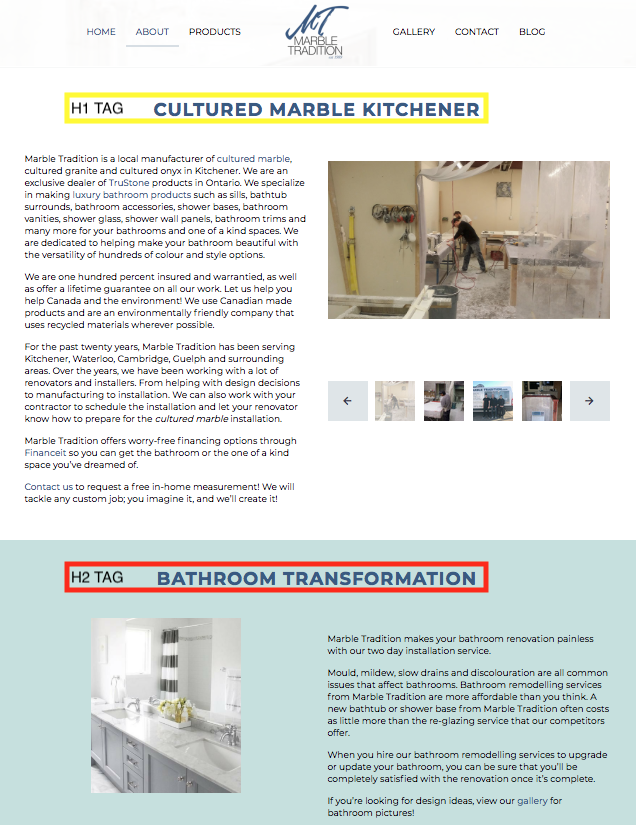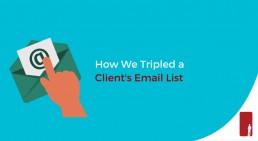Web Design Trends to Take Your Conversions to the Next Level
If you’ve been wondering why your conversion rate has reached a plateau or even dropped, then maybe it’s time to take a serious look at your web design.
Did you know that 75% of users will make a judgment about your company’s credibility based on the design of your website? And as we all know, trends come and go – so if you don’t keep abreast of the latest ones, your potential clients are likely to bounce away from your site.
Thankfully you don’t have to search too far because DesignAdvisor has conveniently compiled all you need to know about current trends in an excellent infographic called “15 Web Design Trends 2018.”
Here you can learn some impressive stats and facts which drive home the importance of well thought out web design. You will also see the benefits of making sure your website is in top condition, and any expense involved will be well worth it in the long run when you start reaping the rewards.
There is a comprehensive list of features that are characteristic of successful web design, so you can check how yours measures up. For example, ease of navigation, engaging content, and good search functionalities, to name a few.
Throughout the infographic, you can find convincing case studies showcasing companies that saw dramatic improvements after making changes to certain areas of their website. Then there are the latest trends in terms of layouts, backgrounds, fonts, illustrations, grids, gradients, page transitions, and much more.
So if you want to take your conversions to the next level, this is a great place to start and get some ideas on how to improve your web design. Stay up to date with the latest trends and see your conversion rates skyrocket.
Infographic URL: https://designadvisor.net/blog/web-design-trends/
How We Tripled a Client's Email List
First, I wanted to share some statistics around email campaigns and the success associated with them. The average open rate for email campaigns across all industries is 21.8% and the average click-through rate is 2.78%.
So, if your email list has 10,000 emails on it, 2180 individuals will open that email. Out of the 2180, you will have 278 individuals click a button in the email and land wherever you have asked them to land.
It varies between industries and I will use retail as an example because it sits very close to the average and it’s relevant to the example I will talk about below. Retail as an industry lands at 21% open rate and 2.5% click-through-rate.
Here are some factors that influence the success rates of email campaigns (open rates and click-through rates):
Mobile Optimization
If your email is not optimized to fit different size screens and devices your click-through-rate will be significantly lower.
Email Subject Line
Research shows that 47% of users open an email based on the subject line.
Value Offer
Be clear on how the recipient will benefit from the value you are offering, whether it’s content or promotional pricing.
Landing Pages
Once you get the user to open the email and click on the desired button, it is important that they land on a page that makes it easy to complete the action you wanted to complete. Simple and loud call-to-actions, solutions for the problems your audience is trying to solve, and unique value are some of the things to be included on the landing page. Too much content and navigation can create uncertainty and can cause the user to get interrupted mid-way or prompt more research.
If you are a retailer, you have plenty of opportunities to capture emails at the point of sale and get permission from your customers to stay in touch. Retailers that ignore email capture are setting themselves back and lose out on potential revenue. The cost of capturing emails in-store is very low, if not free. Setting up an email campaign and managing your email list is not very costly and if the campaign is setup properly, with enough emails, of course, it will always produce a positive ROI.
If you are a multi-location, high transactional volume retailer, the speed at which you can grow your email list is much faster than a single unit, high ticket/low transaction volume retailer. We recently partnered up with a luxury eyewear retailer and helped them triple their email list.
Case Study - Eyeconcept
Eye Concept is a local luxury eyewear retail store, staffed with licensed Opticians and an Optometrist on-site. They are located in Oakville Place and have been there for about 6 months.
We brainstormed with the owner on how to increase awareness in the community around the existence of their store, drive more traffic to the store, and increase their existing email list. Knowing their goals, we planned an event that incorporated all three objectives.
First, we set up an online contest that awarded two winners a free pair of Tom Ford sunglasses. Next, we secured space in the middle of the mall for two days to do a live event. Finally, we launched the contest a week before the live event and encouraged the team at the store to sign people up to the contest, not only when purchasing a product but when they just come in to browse.
While the store was not busy, we encouraged the team to stand outside and engage people walking by to sign up for the contest. In order to sign up for the contest, the user had to leave their email address. Consent to be added to their email list was optional, but we found that 72% of our contest entrants gave consent to send them future promotional emails.


The entrant was able to earn extra ballots by inviting friends to participate through a unique URL, or by liking their Facebook and Instagram page. This add-on helped increase our social media followers.
We promoted the contest on Facebook and Instagram locally as well. On the day of the live event we set up a backdrop in the middle of the mall brought in two digital screens that advertised the contest, and set up an iPad stand to encourage people to sign up for our contest.
We also brought a Polaroid camera that allowed mall patrons to take a picture in front of our backdrop while trying out some models of their exclusive lines of sunglasses and some party props. The crowd was able to walk away with good memory and a printout picture from the polaroid of them having fun under our brand.
We also encouraged all visitors to go down to our retail location and receive a free gift. We had swag giveaways that we distributed to all visitors. This action allowed mall patrons that would normally miss their store to come in, visit the store, get to know the team, the variety of products they sell and helped build more exposure around their store.

 The live event was on for two days and we continued the on-line contest for another week. After two weeks of total contest entries and the live event, we were able to triple our clients’ email list. The total number of email addresses collected was almost an even split between the live event and the in-store/online activity.
The live event was on for two days and we continued the on-line contest for another week. After two weeks of total contest entries and the live event, we were able to triple our clients’ email list. The total number of email addresses collected was almost an even split between the live event and the in-store/online activity.
Not only did we triple our clients’ email list, but we also exposed our clients’ store and brand to the local community increased brand awareness and provided a memory for their future clients. In the following months, we are able to measure the direct impact the contest and the live event had on total sales.
The impact of Experiential Marketing events had been proven tough in terms of hard data and ROI. The experience of the participants can be measured through various surveys, email sign-ups/social media followers increase, and many other such activities.
The measurement of the impact of the event on total sales and revenue however carries a lot of variables in between that can impact that number. Being a Digital Marketing and Field Marketing agency, we have combined the best of both worlds and have created a product that can more accurately measure the impact of Experiential Marketing on total revenue and Sales. Contact us for more details.
How to Write an Article Optimized for SEO
Content creation is key to your business. It is crucial to regularly produce content or you will lose valuable traffic to a competitor.
Knowing how to write an article optimized for SEO that will rank on the first page of Google is critical if you want to drive traffic to your site. It is a waste of time to create content if your content does not appear among the first couple of results.
In this article, we will cover the 5 steps on how to write SEO articles:
Step 1: Select the Right Keywords
Selecting the right keywords is a big part of whether or not your content will rank. You can select the best keywords by writing a list of keywords that you are looking to target. Then go on Google Keyword Planner to see how competitive your keywords are and the average monthly searches for each keyword.
For example, if you’re a plumber specializing in basement waterproofing, you might be looking to target keywords such as basement waterproofing, wet basement, and a flooded basement. Or if you’re a financial advisor, you might be looking to target keywords such as financial advisor, financial planning, and financial management.
Step 2: Create a Lengthy Posts
The golden rule of white-hat SEO is to creating lengthy posts. When people spend more time on your site, it will lead to better rankings. Time on site is one of the most powerful metrics when it comes to SEO. Writing shorter is easier and quicker, but writing content in long-form will outperform short content.
You can write long posts by searching for a topic that you want to write about and condensing all of the information that the top 5-10 results present. Therefore, this will allow you to provide the most information out of all of your competitors so you can outrank them.
Step 3: Use Compelling Meta Titles and Meta Descriptions
When you use compelling meta titles and meta descriptions, this will increase your click-through rate (CTR). CTR is an important factor that Google takes into consideration when ranking sites. When it comes to your meta descriptions, you have 160 characters to convey a general idea of your post. Make it count by leaving some cliffhanger at the end to make people inclined to read more.
For example, if you’re looking for condos for sale North York, would you be inclined to click on a site with the metal title “Condo 3 bedroom North York - Trovit?” Below is an example of a good and bad meta title and meta description.




Step 4: Structure Your SEO Article
You have to make sure you structure your SEO article using H tags to divide your content into sections. You can do this by using the H1 tag for the blog post title and H2, H3, H4 tags for your subheadings. You should also include images to make your content more engaging and use alt text on all your images.
Take a look at Marble Tradition’s site. They are using the H1 tag for cultured marble Kitchener and H2 tag for bathroom transformation as their subheading.


Step 5: Permalink Should Include Main Keywords
Your URL should include the main keyword that you’re looking to rank for that specific web page or blog post. You should try not to use stop words such as “a”, "to", "an", “the”, and “is” in your URL.
For example, in this article, my permalink is "write SEO articles" rather than "How to Write an Article Optimized for SEO."
Try these 5 steps on how to write SEO articles and let us know how your article did! You can comment on the article below or drop us a line at info@retailorsgroup.com.
What is Content Marketing and How Can It Help Your Business?
In a nutshell, Content Marketing is an indirect way of connecting with consumers through materials that do not directly promote a product or service but instead sparks interest and thoughts around products or services that you do sell.
The intended outcome of using Content Marketing would be to gain a new customer but the path at gaining that new customer is very different than your traditional marketing efforts.
If you are able to provide relevant and useful information to consumers that perhaps answers a question or educates them on something that you do, you are taking steps towards showing the public that you are an authority in your industry and a trusted source on that topic. This will give you credibility and increase your audience. Once your audience increases, you will now have a larger and more engaged group of individuals to directly advertise to.
Furthermore, Content Marketing is great for your Search Engine Optimization. The greater content that you produce and share on various platforms, the greater the chances your content will be shared by others, sending positive signals to search engines like Google on how relevant and authoritative your website is.
There are various forms of Content Marketing and we will cover some of them off in this article.
Blog Posts
Posting regular and informative blogs on your company’s website is a great way to educate consumers on your products or services. To really make this work though you should always try to write your blog in a way that answers a question or educates consumers on something that they may have never known.
One of our partners, AWealth, has a very informative blog on Financial Services on their website. Here is one of their blogs on ‘What is an RRSP Loan?’.
As you can see, AWealth wrote this blog to answer a question. At the same time, it also served as an educational piece. The key part about the article was there was no hard sell on getting an RRSP or RRSP loan from them.
Social Posts
Being active on Social Media is perhaps one of the most popular forms of Content Marketing. As of January 2018, Statista reported that Facebook had 2.2 billion active users on its platform! Talk about a wide audience to market to.
The important thing to remember about your posts is to answer a question or to educate. With social media, you can also diversify what you’re posting. Get your customers involved with sharing their photos of them using your product or service. Share other companies or individual blogs that relate to your business on your social site. You can even use this opportunity to showcase pictures of your product or your service in action.
Our partner, Bamboo Legend, does a great job with content marketing on their Instagram account. Their posts showcase their mouth-savouring food but they also take an opportunity to educate the masses on Thai culture.
Infographics
Infographics are graphic visual representations of data or information that are intended to present complex information quickly and clearly. (source: TheNextWeb)
Pinterest is a popular platform where infographics are commonly used. We’ve posted some infographics on our Pinterest page to quickly summarize some of our blogs in a more visual manner.
Infographics can also be used nicely within your website to visually show steps or processes that your company uses to get work done. They can also be used within your blogs to better explain detailed points within your article.
Do you have a lot of statistics that you want to better explain to your audience? Infographics will definitely be your best form to represent that.
Other Forms of Content Marketing
Videos are another great form of Content Marketing. There are 1.5 billion active YouTube users in the world. Video is steadily becoming the most served up content on the Internet. Google searches commonly show video results on a lot of question-based queries and Facebook also gives greater organic reach on videos.
In the spirit of answering questions and educating users, consider adding a ‘How-To’ section on your website. How-To guides are another form of Content Marketing and are sure to draw a lot of attention giving you once again more authority as a subject matter expert. Mix in some of the suggestions in this article like infographics and videos.
Putting together case studies on previous projects is another way you can indirectly promote your company. Give visitors real-life examples of how your product or service helped a previous client.
Hosting webinars and or seminars is another way to utilize content marketing. This is a great way to communicate with your consumers immediately and directly. Remember, cater to these webinars and seminars to answer a question or to educate.
Establishing your Online Presence as a New Business Owner
Deciding to venture off and be a new business owner is an exciting time. Albeit exciting, any existing or new business owner knows that the first stage of opening your new business is tough, painful, risky, requires long hours, and can be stressful at times.
You are trying to get your business off the ground and you start to realize that prioritizing your time will be a challenge. Where do you spend your time? Is it in business development? Maybe you should set up a good accounting system to avoid future pains, or maybe you should spend some time hiring because getting the right people at this stage is key.
Getting caught up in the whirlwind of necessary activities leaves very little time for important but non-urgent activities. We all fall for it. Establishing your online presence as a new business owner at the beginning stages is crucial to have long term success.
Below you will find some items to do in order to establish your online presence as a new business owner.
Get a website

Don’t push it aside for later. It takes time to develop your online presence and the longer you push this aside, the longer it will take for you to be found.
Nearly 50% of small businesses in Canada do not have a website. Here is what they are missing out on:
- 95% of consumers use search engines to find local businesses. Appearing on popular search engines like Google is directly associated with your website. (Source: searchengineland.com)
- Your website is open 24 hours a day, 7 days a week to provide information to your consumers
- Businesses that do not have a website lack credibility. If a potential consumer wants to know more about you but can’t find you online, they might second guess doing business with you.
- Competitors that have websites are taking business away from you
I’m sure there are a dozen or more reasons why you need a website, but we’ll save that for another day.
Related Article: Quick SEO Guide for Small Businesses
Create high-quality content on your website

When the Internet first came about and businesses were creating websites, they treated them more like an online brochure. It was effective back in the day but now websites are best utilized for more than just who you are and what you offer.
You’ve probably heard this before, but here it is again, content is king.
Having a section on your website for a blog or original articles tailored to your audience will allow you to create a community of people that will keep coming back for more.
Small businesses with blogs get 126% more lead growth than small businesses without.
Let’s not forget the benefits of Google loving relevant content and making it available for searchers to find giving you even more people that know people to join your community. The organic momentum from this compound to something greater than you could have ever imagined.
Get on social media

Social media is not just about liking pictures and entertaining yourself. If you’re a small business owner, there are a variety of reasons to get onto social media.
A staggering 67% of the population in Ontario, Canada use social media. Those that use Facebook specifically spend on average 40 minutes a day on this social platform.
Outside of the large audience, having a social media presence helps with brand awareness, loyalty, and authority. Consumers and search engines will establish more trust behind your brand when you’re available on social media.
Similar to your website, having a presence on social media isn’t just about showcasing who you are and what you do. Remember that cool content that you are producing on your website? Share it on social media! Your reach will now exponentially increase.
Related Article: 7 Reasons Social Media Marketing is Still Underrated
Being available on social also gives you the opportunity to improve your customer service. Giving consumers a platform to express delights and frustrations gives you, the business owner, a chance to show gratitude and gain valuable feedback. Those that are upset will allow you to try and turn an unhappy customer into a happy one.
There is quite a bit of platform you can choose to establish your social media presence. Don’t try to get on every platform. Find what works for you and your industry and stay active. It’s better to have one social media account and be hyperactive vs being on 4 and not being active.
Register your company and website on business directories

Staying consistent with various points made in this article, registering on online business directories helps to further increase your online presence.
Ultimately, you want to be found online and there are a plethora of directories that you can register on. There are free ones and paid ones, so do your due diligence on finding the right one for your business. Here is a good list of online directories to check out.
Once you establish your website and social media accounts with relevant content you can point these sources to these directories. In turn, these directories will work on your behalf to point consumers to you.
You will now be accessible, visible, and reputable once you tie all of these components together.
Remember, getting your online presence may seem non-urgent but it is very important. It is a lot of hard work that requires nurturing in order to develop but the rewards will be well worth the time.
About Retailors Group
The team at Retailors Group has over 15 years of retail sales and field marketing experience. Retailors Group takes the time to understand your brand and align your core values into a tailor-made solution that builds a long-lasting relationship with your consumers.
We offer services in Experiential Field Marketing, On-site Sales Assist, Retail Management, and Digital Marketing.





